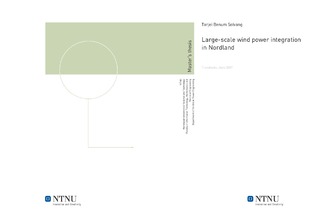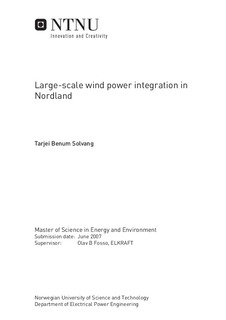| dc.description.abstract | Nord-Norsk Vindkraft AS is planning to build two wind farms in Nordland, Norway. The wind farms are located at Sleneset and Sjonfjellet. The planned total installed power is 653 MW. An important part of the planning phase is to perform steady-state and dynamic analyses, to simulate the impacts from the wind farms on the existing power system in the area. The steady-state analysis is performed by Norsk Systemplan og Enøk AS (NORSEC). The project presented in this master thesis is part of the dynamic analysis. The overall objective for this project is to illustrate the dynamic impacts from the wind farms on the existing power system and the differences in impact depending on the various control strategies being used. The following elements are included in the assignment: - Establish a steady-state and dynamic grid model describing the power system in question. - Determine whether the wind farms are able to reach full production during different configurations without reaching an unacceptable operating state. - Examine the impact from and behaviour of transformers with load tap changers. - Illustrate the differences between different control modes in the wind farm connection point. The model used in this project is established by converting the steady-state model used in the steady-state analysis from Netbas to SIMPOW. The time in the steady-state model is set to January 2009. The steady-state model is then expanded by introducing aggregated doubly-fed induction generators for power production in the wind farms. For some of the simulations, a static VAR compensator is inserted at Bardal. The dynamic model is established by introducing a dynamic description of the components in the steady-state model. Due to lack of dynamic data, typical values are used for some of the components. The comparison between the power flows from the basic model provided by NORSEC and the initial converted SIMPOW model show small differences in reactive power flow. These differences were, however to be expected, due to changes made when converting the model from Netbas to SIMPOW but are not considered important for the conclusions to be drawn from the project. Simulations describing an increase in wind power production from 50% to 100% are performed on the dynamic model describing the grid between Salten and Tunnsjødal. The timeframe of increase varies depending of the objective for the specific case. The simulations performed on the dynamic model indicate a need for reactive power compensation between the wind farms and the connection point at Nedre Røssåga. Without reactive power compensation on the radial connection, the wind farms are not able to reach full wind power production without breaching either voltage or thermal limits. This is the case even if local compensation is added at the wind farms. With an SVC in voltage control placed at Bardal, the wind farms are able to reach full power production without violating any specified limits. The SVC maintains acceptable voltage levels within the radial. However, the amount of imported reactive power at the connection point increases during the production increase. This causes a depression in voltage in the rest of the grid. If the SVC at Bardal is set to control the reactive power flow in the connection point, simulations indicate that the amount of reactive power drawn from the main grid can be considerable reduced. This, however, results in a larger need for reactive power production within the radial. A larger reactive power production increases the voltages. Without voltage control at the wind farms or voltage regulation by load tap changers, the simulations show that the voltage at the generator terminals increases above 1.05 pu. Simulations demonstrate that tap-operations in the transformer at the connection point between the main grid and the wind farm radial increases the amount of imported reactive power. This takes place when the SVC operates in voltage control. The need for reactive power production within the radial is then reduced. The tendency is the same whether voltage control is introduced at the wind farms or not. When the SVC operates in reactive power control and no voltage control is present at the wind farms, tap-operations from the same transformer result in an increase in reactive power production within the radial. However, if voltage control is included at the wind farms, tap-operations at the connection point will decrease the reactive power production. This is because in voltage control the wind farms are consuming reactive power in order to maintain a specified terminal voltage. The results from the simulations indicate that the number of tap-operations from the transformer at the connection point is reduced when the SVC at Bardal operates in reactive power control compared to when it operates in voltage control. However, no wind models based on statistics are introduced in this project. It is therefore uncertain to what extent a similar result would be obtained under more realistic conditions. All the simulations show that when the production from the wind farms increases, the voltages in the grid outside the radial decreases. This is due to increased reactive losses. The decrease is largest when the SVC at Bardal operates in voltage control due to reactive power drawn by the radial connection. The area in the main grid with the largest decrease is located between the connection point at Nedre Røssåga and Trofors. This project is only a part of the necessary dynamic analyses that have to be carried out in the planning phase for the wind farms at Sleneset and Sjonfjellet. A natural continuation of this project could be to perform analyses in a light load situation, and analyses of the system s response to disturbances. Wind models obtained from statistical wind data should also be included in future dynamic analyses. | nb_NO |

